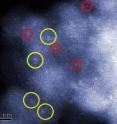NIST and partners identify tiny gold clusters as top-notch catalysts
For most of us, gold is only valuable if we possess it in large-sized pieces. However, the "bigger is better" rule isn't the case for those interested in exploiting gold's exceptional ability to catalyze a wide variety of chemical reactions, including the oxidation of poisonous carbon monoxide (CO) into harmless carbon dioxide at room temperatures. That process, if industrialized, could potentially improve the effectiveness of catalytic converters that clean automobile exhaust and breathing devices that protect miners and firefighters. For this purpose, nanoclusters—gold atoms bound together in crystals smaller than a strand of DNA—are the size most treasured. Using a pair of scanning transmission electron microscopy (STEM) instruments for which spherical aberration (a system fault yielding blurry images) is corrected, researchers at the National Institute of Standards and Technology (NIST), Lehigh University (Bethlehem, Pa.) and Cardiff University (Cardiff, Wales, United Kingdom) for the first time achieved state-of-the-art resolution of the active gold nanocrystals absorbed onto iron oxide surfaces. In fact, the resolution was sensitive enough to even visualize individual gold atoms.
The work is reported in the Sept. 5, 2008, issue of Science.
Surface science studies have suggested that there is a critical size range at which gold nanocrystals supported by iron oxide become highly active as catalysts for CO oxidation. However, the theory is based on research using idealized catalyst models made of gold absorbed on titanium oxide. The NIST/Lehigh/Cardiff aberration-corrected STEM imaging technique allows the researchers to study the real iron oxide catalyst systems as synthesized, identify all of the gold structures present in each sample, and then characterize which cluster sizes are most active in CO conversion.
The research team discovered that size matters a lot—samples ranged from those with little or no catalytic activity (less than 1 percent CO conversion) to others with nearly 100 percent efficiency. Their results revealed that the most active gold nanoclusters for CO conversion are bilayers approximately 0.5-0.8 nanometer in diameter (40 times smaller than the common cold virus) and containing about 10 gold atoms. This finding is consistent with the previous surface science studies done on the gold-titanium oxide models.
Source: National Institute of Standards and Technology (NIST)
Articles on the same topic
- Scientists peel away the mystery behind gold's catalytic prowessThu, 4 Sep 2008, 21:15:11 UTC
Other sources
- Tiny gold clusters seen as good catalystsfrom UPIWed, 10 Sep 2008, 13:50:27 UTC
- Tiny Gold Clusters Are Top-notch Catalystsfrom Science DailyMon, 8 Sep 2008, 5:28:37 UTC
- Scientists Peel Away Mystery Behind Gold's Catalytic Prowessfrom Science DailySun, 7 Sep 2008, 22:21:50 UTC
- Researchers Identify Tiny Gold Clusters as Top-Notch Catalystsfrom Newswise - ScinewsSat, 6 Sep 2008, 20:28:08 UTC
- Scientists Peel Away Mystery Behind Gold's Catalytic Prowessfrom Science DailyFri, 5 Sep 2008, 12:35:26 UTC
- Scientists peel away the mystery behind gold's catalytic prowessfrom PhysorgThu, 4 Sep 2008, 21:14:06 UTC
